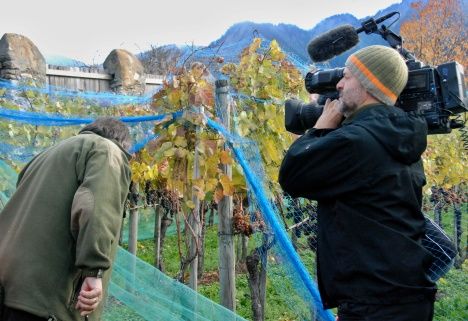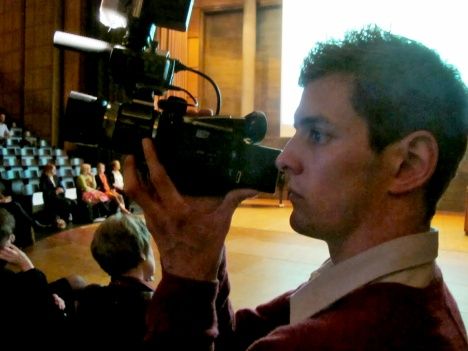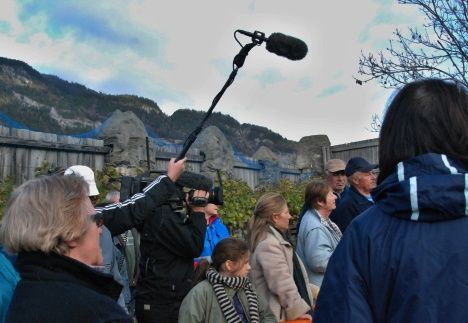Every now and then, you have to go back to your own roots, maybe also to prove to yourself that you are not always just a driven person, but that you can definitely also drive. My professional roots are not in wine, but in communication, more precisely, in the audio-visual mediation of journalistic content. It reads a bit complicated, but it is nothing else than what used to be called television work. I was a television journalist all my professional life, and later also a lecturer at the University for Image and Sound Design. No wonder that I am particularly interested in television programs about wines and vintners. Wine and television, two areas that are related in one very decisive point: in their emotional content. Wine is not simply a drink that tastes more or less, and in image and sound not only information can be disseminated, emotions are always aroused - whether with wine or television - whether one likes it or not.
 |
| Television footage in the vineyard (Photo: P. Züllig) |
Wine not only provides taste information and signals, it also always arouses emotions and leads purposefully and quickly to experiences, good and bad, beautiful and ugly. Those who take wine seriously and enjoy it - not just down it - always have a range of feelings aroused, because enjoyment is a sensory sensation - a feeling of well-being - which presupposes the feeling - the emotion - and can only take place at all in subjective experience. But this is exactly what is infinitely difficult to convey to others, to reproduce or make comprehensible. Listing facts and information, evaluating, praising or blaming are not enough to do justice to the effect and power of feelings. It remains with an auxiliary construction, which is often ridiculous and awkward, mostly anything but convincing and almost always far away from the emotional reality.
There are, however, methods by which feelings, though not explained, can be conveyed quite adequately. These include storytelling, especially when it is done in pictures and with sound, for example in the cinema or on television. Therein lies the strength and power of cinematic design. It is the immediacy of the experience. In the cinema and on television (nowadays also on the computer) this happens virtually, while in the consumption of wine it happens in real terms during pleasurable drinking. But they are the same feelings, they do not differ, whether virtual or real.
 |
| Television production site - from here information is disseminated and the viewers' feelings are appealed to (Photo: P. Züllig) |
So what could be more obvious than to make full use of the power of image and sound to bring information to the screen, especially if one wants to inform about the enjoyment potential of wine. But this is exactly what hardly ever happens. It is true that there are always films (videos) about wine regions, wineries and their wines, about consumers and their experiences. However, they are mostly "told" as if it were a picture potpourri, a picture book that can be leafed through almost at will. Everything that is even remotely visually attractive is strung together and spliced with non-stop commentary. In order to still create some emotion, the picture is underlaid with music - just as non-stop. The original sound - except for statements or interviews - is taken back, faded out or simply neglected. So it happens that a heavy tractor floats weightlessly through the picture, accompanied by some dramatizing background music; that the work in the vineyard takes place silently and wine drinking has to serve as a tapestry for more or less meaningful comments. No wonder I get annoyed, almost every time wine and the wine world are reported on television, usually as if it were a documentary of forgotten emotions.
 |
| Media training at the university; here, it is not the craft that is learned% but the effect of the image that is researched (Photo: P. Züllig) |
A current example of this kind of picture book sequence and unimaginative film design, of garrulous information transfer and forgotten sound design, of beautiful images without dramaturgical functions, can be found in the three-part series "Weindynastien" (Wine Dynasties) by Bavarian Television (BR). If you watch the three videos one after the other, you will sense - even if you know nothing about film theories - how different such documentaries can be. One time it is picture and text information, strung together like sleeping chickens on a roost, in the other production it is a jumble, comparable to startled chickens clucking non-stop, wandering around in the yard and picking up something here and there. And finally, in the best of the three productions, a succession of small episodes that attempt to convey information largely through sound and images (often with little text). To stick with the chicken analogy, a farm where many chickens are united and yet each of the chickens has its own life (and story) and yet together they form a whole, a chicken farm.
 |
| To each picture belongs an original sound: it is able to trigger more emotions than the picture itself (Photo: P. Züllig) |
This is not a plea for unimaginativeness and boredom, but rather an impulse to restraint, observation and documentation, in which the experience - the feeling - also has its place. From a purely technical point of view, the difference in these - and many other - television reports about wine can be established again and again. Thus, for example, the best of the three contributions, compared to the most loquacious of the three productions, manages with half of the commentary, but it contains about three times as many statements (statements of the participants, which are not undercut with arbitrary images), largely does without music and instead allows the original sounds (episodic communication among the protagonists and characteristic sounds) to work, without immediately covering them up again with text.
This is where the wine lover meets the film designer. I experience this in myself. Wherever - in film design or wine consumption - I don't try to describe and explain non-stop, where reality is not constantly packed into schemes and analogies, but remains on its own, as an experience, as a core of reality (virtual or real), that's where stories emerge; that's where a cosmos is formed in which information, experience and communication combine and communicate that which ultimately comes closest to so-called reality. For reality does not consist solely of facts, figures, processes, descriptions, physical quantities and measurable dimensions.
Especially with wine, the experience, the pleasure, the feeling takes on a dominant function, with which the quality is defined and the craft of winemaking is determined. If this is captured in film (video) in image, sound and movement, the experience must not be neglected or even missing. Film and wine are much more closely related than we think, you just have to recognize this relationship and make use of it.
Cordially
Yours sincerely